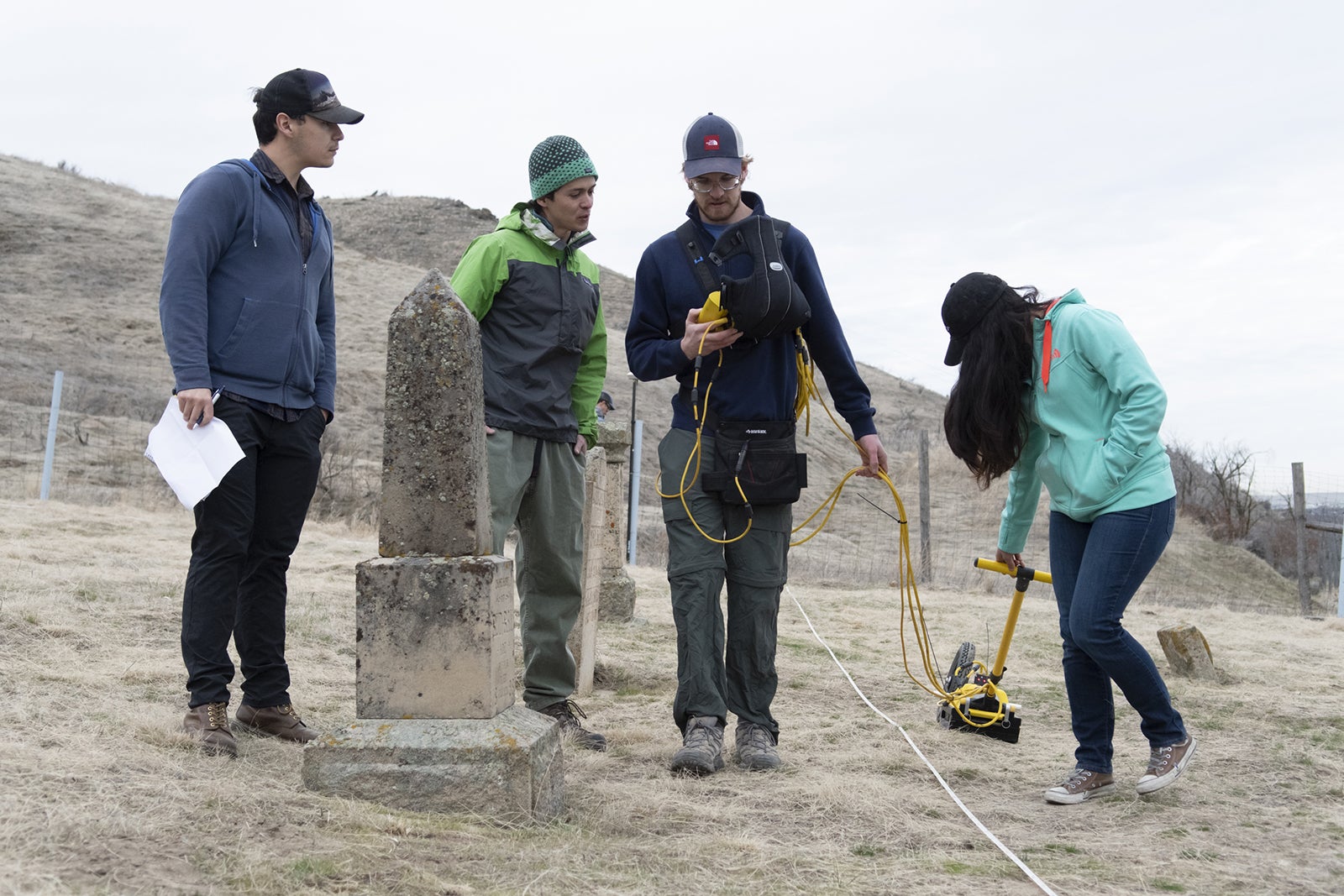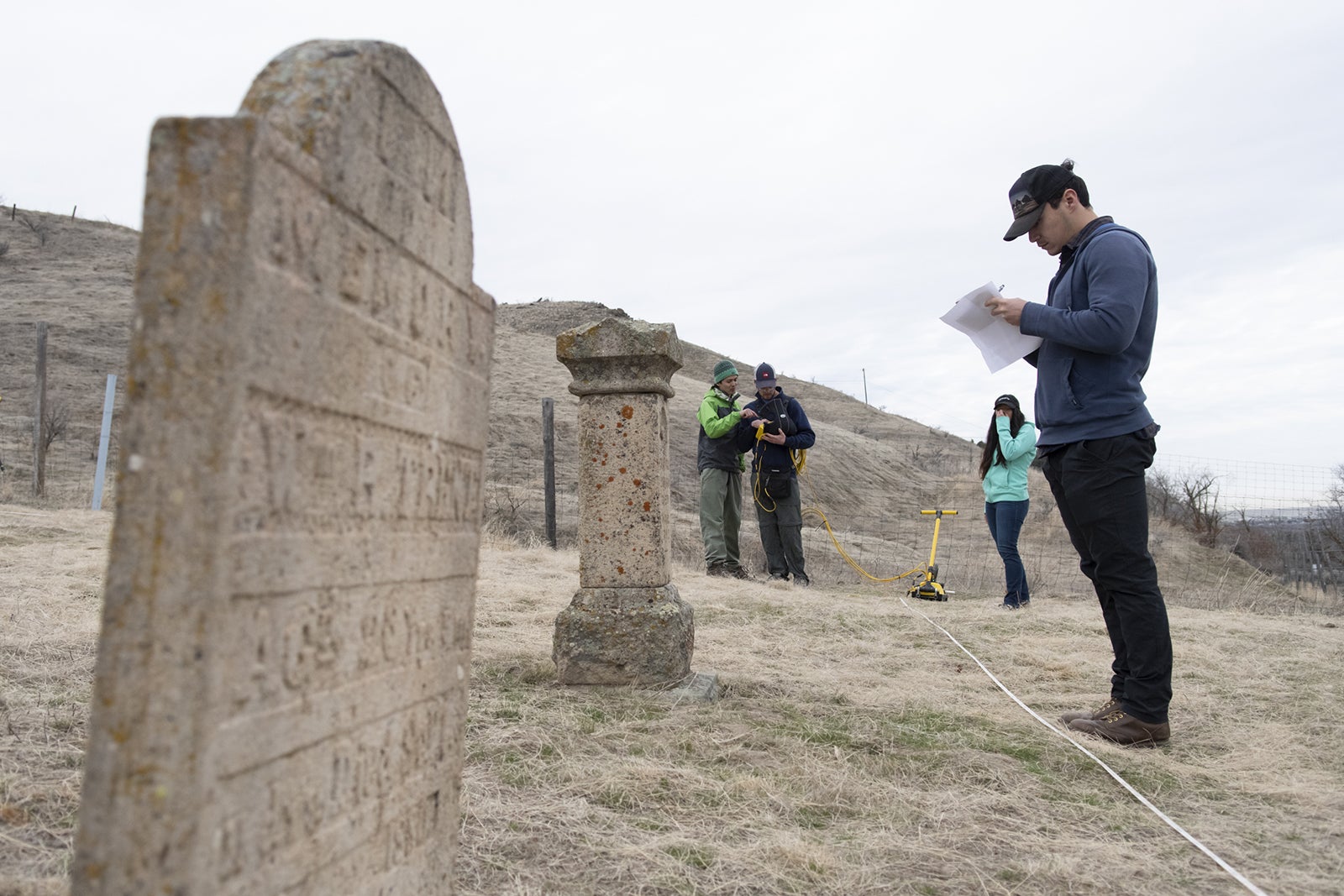
On a bright and chilly spring morning, the Boise State Geophysics Club was engaged in a rather somber task. Members were using ground-penetrating radar, magnetometers and GPS to begin locating the graves of inmates buried in the cemetery at the former Idaho State Prison, now the historic site known as the Old Idaho Penitentiary on Warm Springs Avenue.
Of the 129 people who died there, at least 55 were buried on site, including six of the 10 inmates executed during the prison’s century in operation. For some inmates, the prison cemetery was a kind of potter’s field. Their families could not pay funeral costs or could not be located. In other cases – including that of murderer Raymond Snowden, the last man executed at the site in 1957 – families chose not to claim the body. All the graves were marked at some point in the past, and several stones do remain, including two placed by the U.S. Army for inmates who were veterans. But years of weather and vandalism have taken their toll on other markers.
In addition, prison officials didn’t always keep careful records of burial sites to begin with, said Amber Beierle, a graduate of Boise State’s history program and historic sites administrator for the Idaho State Historical Society. She and her fellow historians have used newspaper accounts, inmate death certificates, fuzzy copies of hand-drawn maps and other clues to try and figure out where bodies are buried. She’s hopeful the Geophysics Club can help clear up a few more mysteries by identifying the perimeters of individual graves, and perhaps even the depths of coffins.
Building Community Bonds
The partnership between the Old Idaho Penitentiary staff and Boise State has been nearly a year in the making. The project is part of the community outreach the club does each semester, said Dylan Mikesell, a geosciences assistant professor and club advisor. Past projects have included helping Nampa Police in an ultimately unsuccessful search for the body of a person missing for more than 50 years, and working with the Boise River Enhancement Network (a group that promotes the health of the river) to find a buried culvert.
Public outreach is “a great way for students to put the skills they learn in class to work,” Mikesell said.

The club has around 10 members. Most are geosciences or geophysics majors, though the club is open to students in all disciplines.
Monica Vermillion, a geophysics master’s student from Ohio, was part of a team using GPS to con rm the locations of known grave sites as a baseline at the cemetery. Vermillion said that while she knew of Boise’s historic prison, the work in the cemetery helped her form a more personal connection to the local community. The prison project included a personal tour of the site that housed inmates from 1872 until 1973.
“It’s good to become a more well-rounded student, learning skills outside of the usual geophysics program,” she added.
Club members will look at the data they gathered at the cemetery to determine what underground graves look like in the sites where graves are known to exist, hopefully finding some distinguishing features in the surrounding soil. Those distinguishing features will become their guide to look for other graves. In the end, and much to the delight of local historians and history lovers, they want to create maps and data visualizations of the cemetery subsurface.
Beierle and the Old Idaho Penitentiary staff will use the Geophysics Club findings to inform future cemetery tours, and provide information for a planned memorial marker at the site. In wanting to install a memorial at the cemetery, the Idaho State Historical Society is neither “vilifying nor sanctifying” any of the inmates, Beierle said.
“This is just about an essential knowledge of history, family history, posterity and creating a more complete story of the Old Penitentiary. As historians, that’s our goal.”
More Boise State Technology at the Old Penitentiary
While the partnership with the Geophysics Club is the first of its kind inside the walls of the cemetery, it’s not the Historic Society’s first technology-based partnership with Boise State. The Old Penitentiary’s on-site J. Curtis Earl Memorial Exhibit holds a collection ranging from medieval arms and armor to Thompson submachine guns.
Thanks to students in the Gaming, Interactive Media and Mobile Technology program in Boise State’s College of Innovation and Design, it also offers visitors a virtual reality experience that recreates a World War I battle trench, complete with weapons and rolling, poppy-covered hills.
Future projects with Boise State include the development of three new mobile apps. One will challenge visitors to a prison scavenger hunt. One will tell the story of the riots that occurred in the 1970s shortly before inmates moved to the then-new prison south of Boise. The third app will be a “ghost capture,” but one that tells the story of real people who lived, and in some cases died, behind bars at the old prison.
“A traditional tour isn’t for everyone,” said Beierle. “And we wouldn’t be able to do any of this without Boise State.”
Originally published in Focus Magazine by Boise State Communications and Marketing